Guide: Microsoft Entra SSO integration with OAuth2-proxy (Tekton Dashboard)
This guide provides instructions on how to configure OAuth2-proxy for the Tekton Dashboard with OIDC authentication using Microsoft Entra as the Identity Provider.
Prerequisites
- Access to the Microsoft Entra Admin Center with administrative privileges.
- Created Microsoft Entra Tenant.
- Installed Tekton Dashboard.
- Installed OAuth2-proxy (can be installed during Configuring Helm chart step).
- Fork copy of the edp-cluster-add-ons repository.
- (Optional) Installed External Secrets Operator.
Configuring Microsoft Entra Application
To configure Microsoft Entra as the Identity Provider for the OAuth2-proxy, it is necessary to create and configure an Application in the Microsoft Entra Admin Center.
-
Log in to the Microsoft Entra Admin Center.
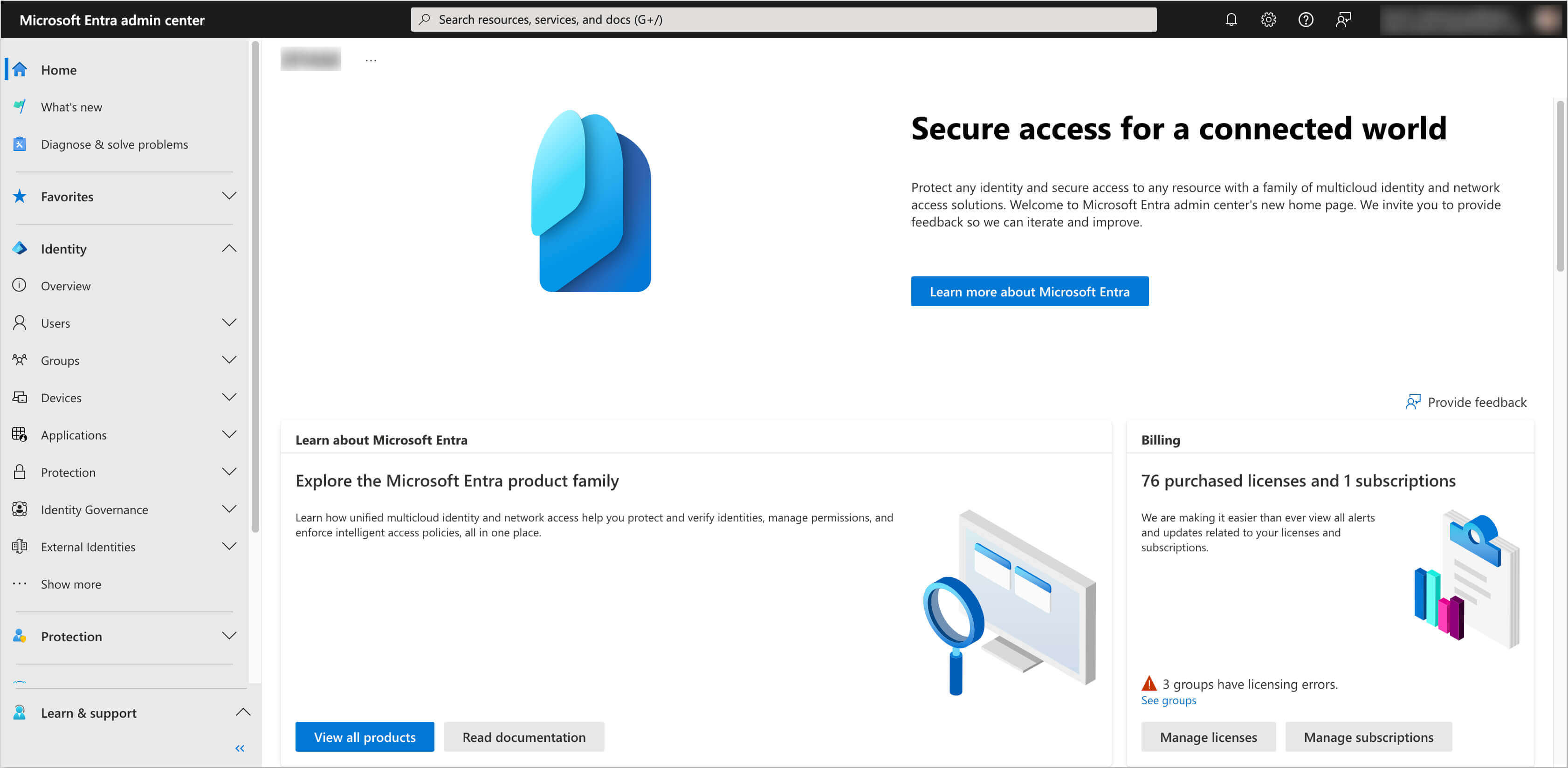
-
In the left sidebar menu, select Applications and click App registrations.
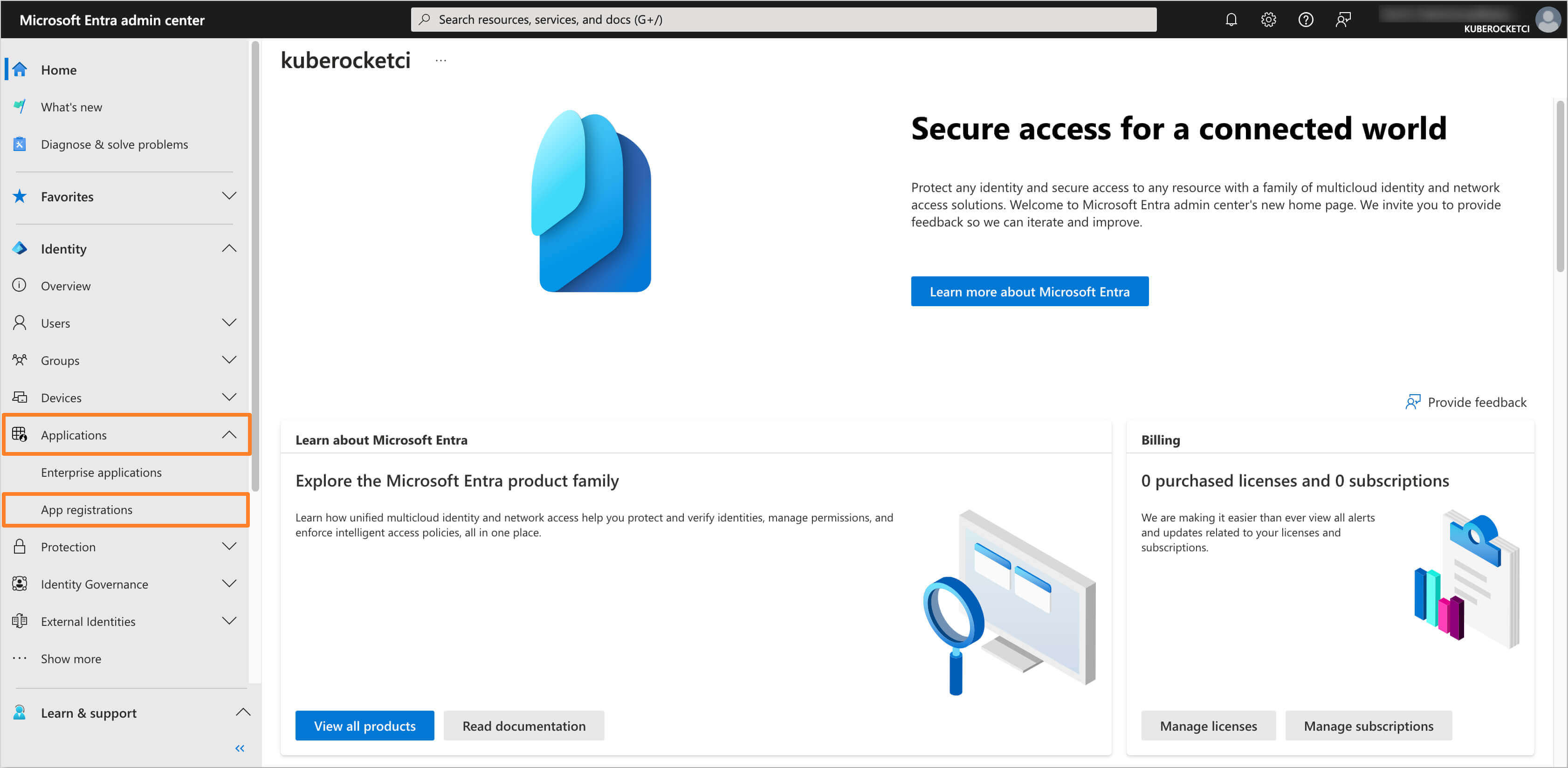
-
Click on the New registration button.
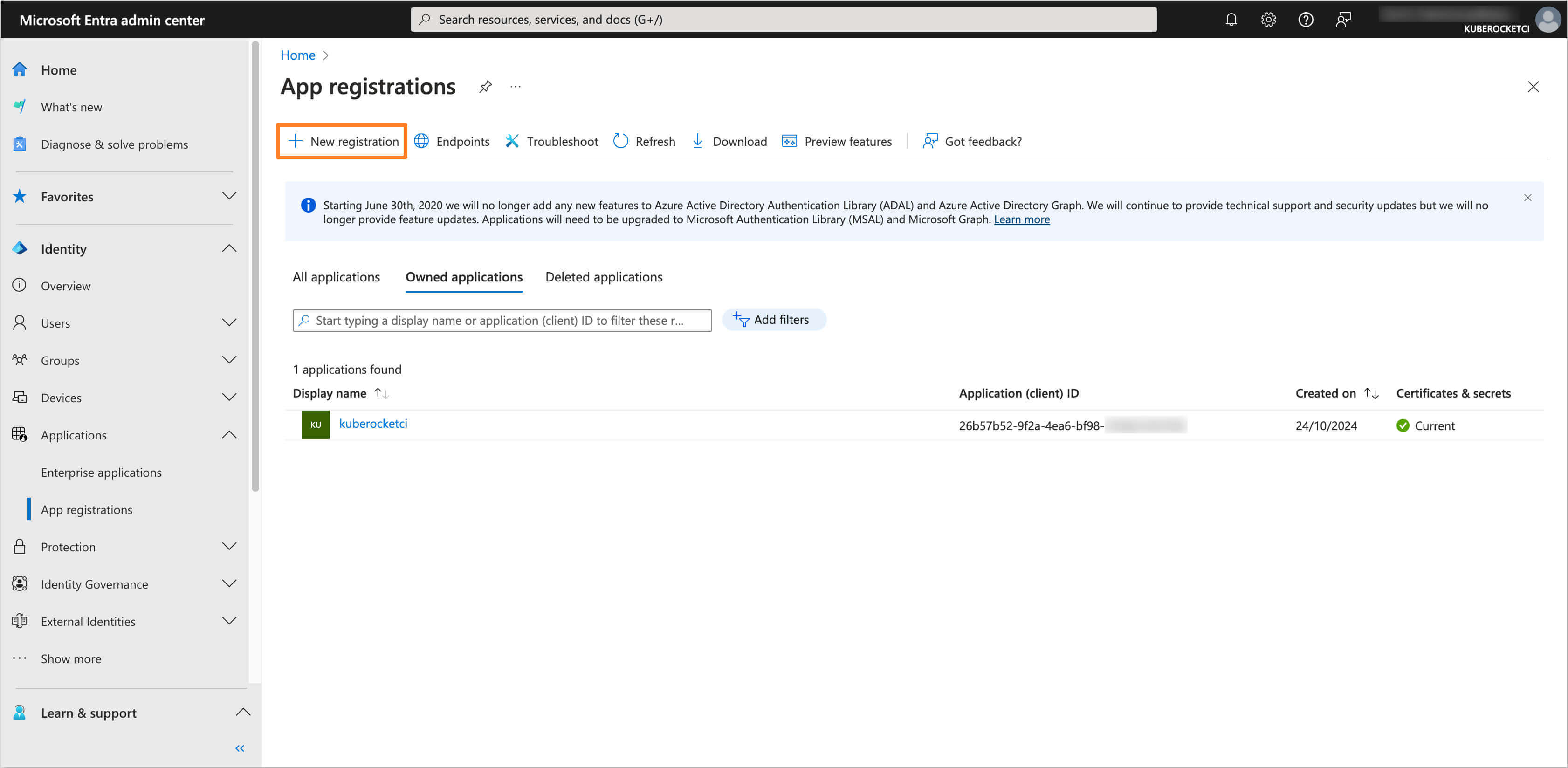
-
Fill in the required fields, such as Name, Supported account types and Redirect URI (You can skip setting the Redirect URI if you don't deploy OAuth2-proxy yet). Click Register to create the application.
noteThe Redirect URI should be in the format
https://<OAuth2-proxy ingress URL>/oauth2/callback.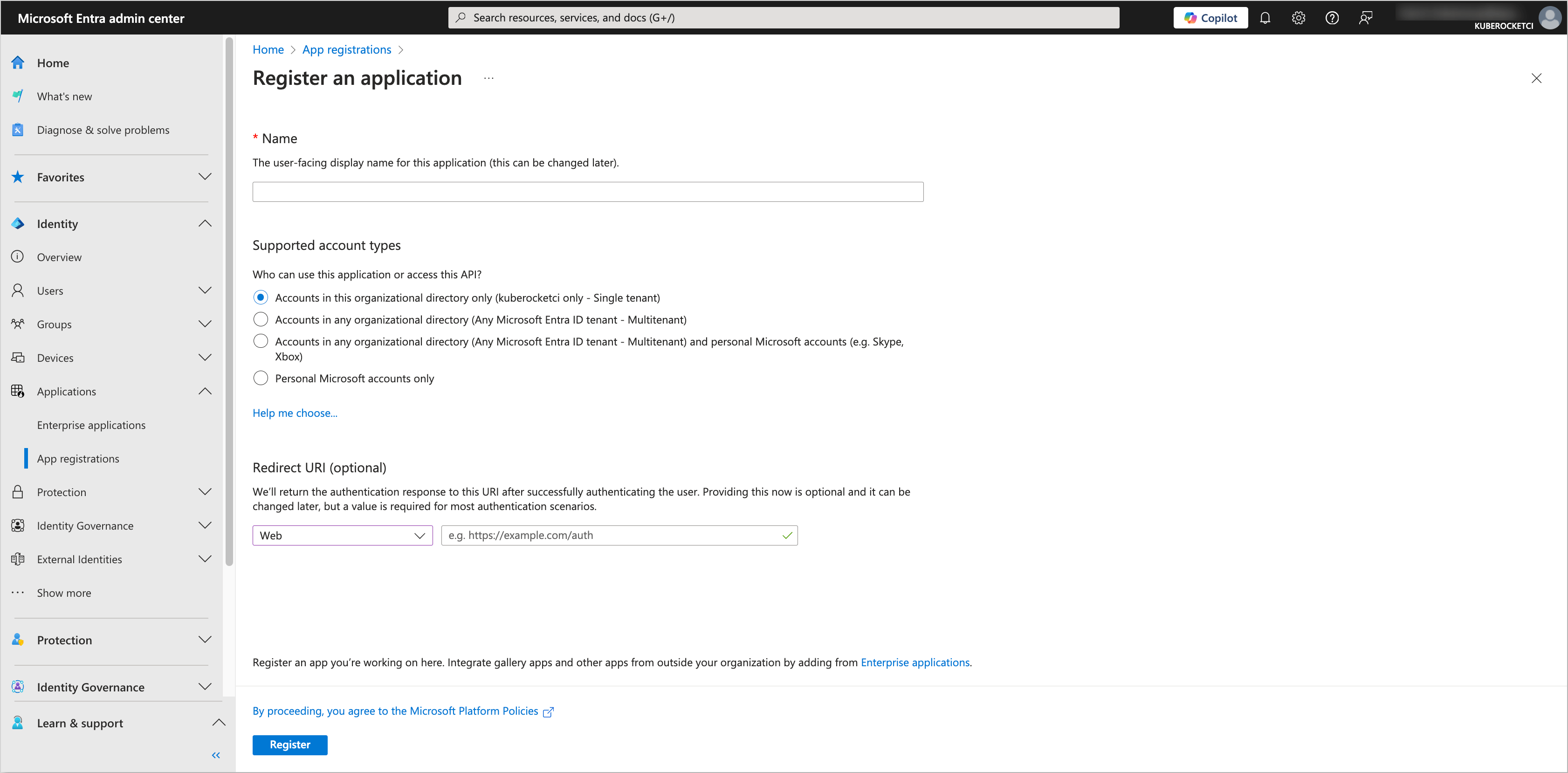
-
In the created application, navigate to the Certificates & secrets section from the left sidebar menu. In the Client secrets tab, click on the New client secret button to create a new secret. Fill in the required fields and click Add.
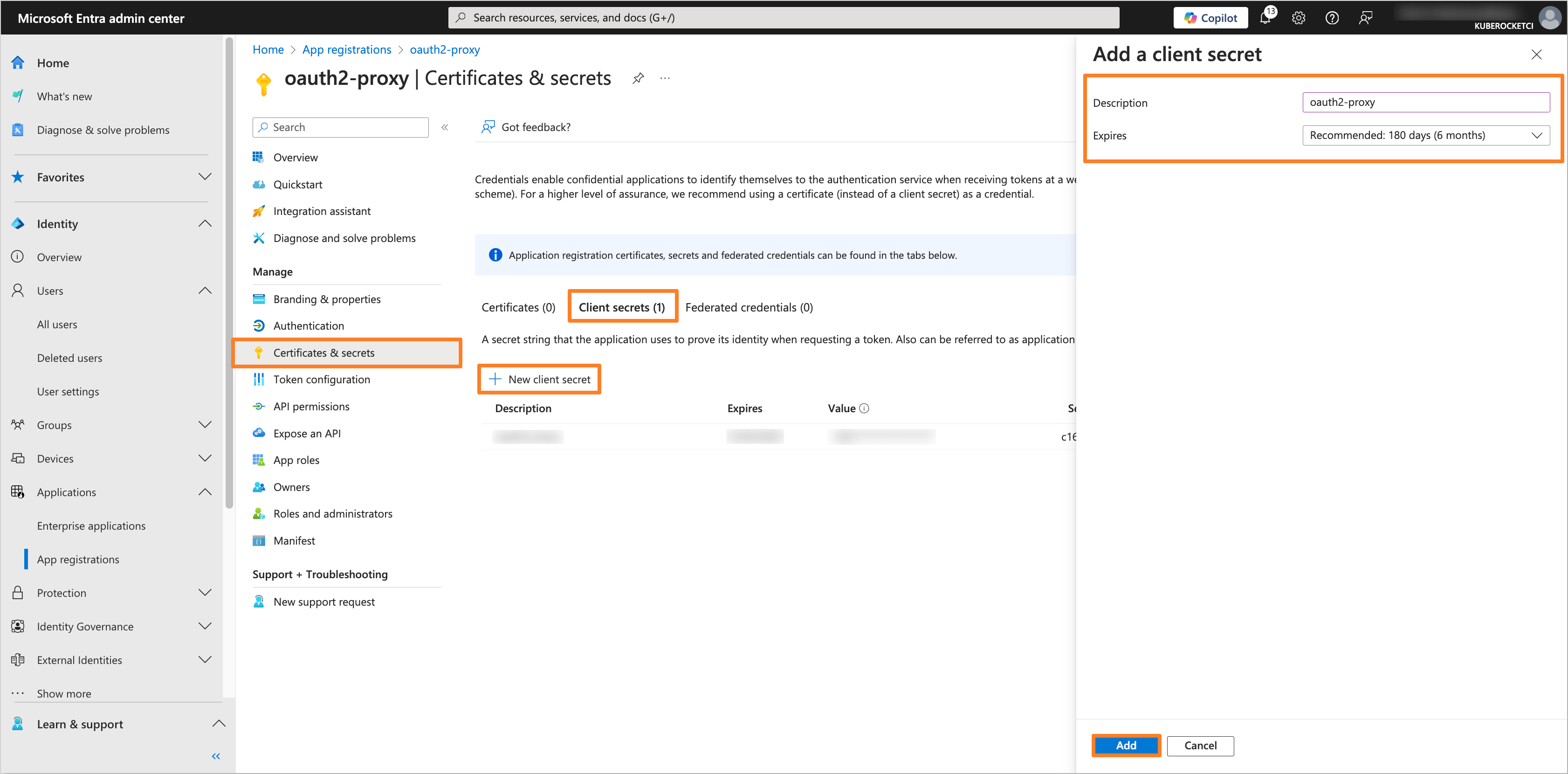
-
Copy the generated Client secret value and store it securely. You will need this value to configure the OAuth2-proxy Helm chart.
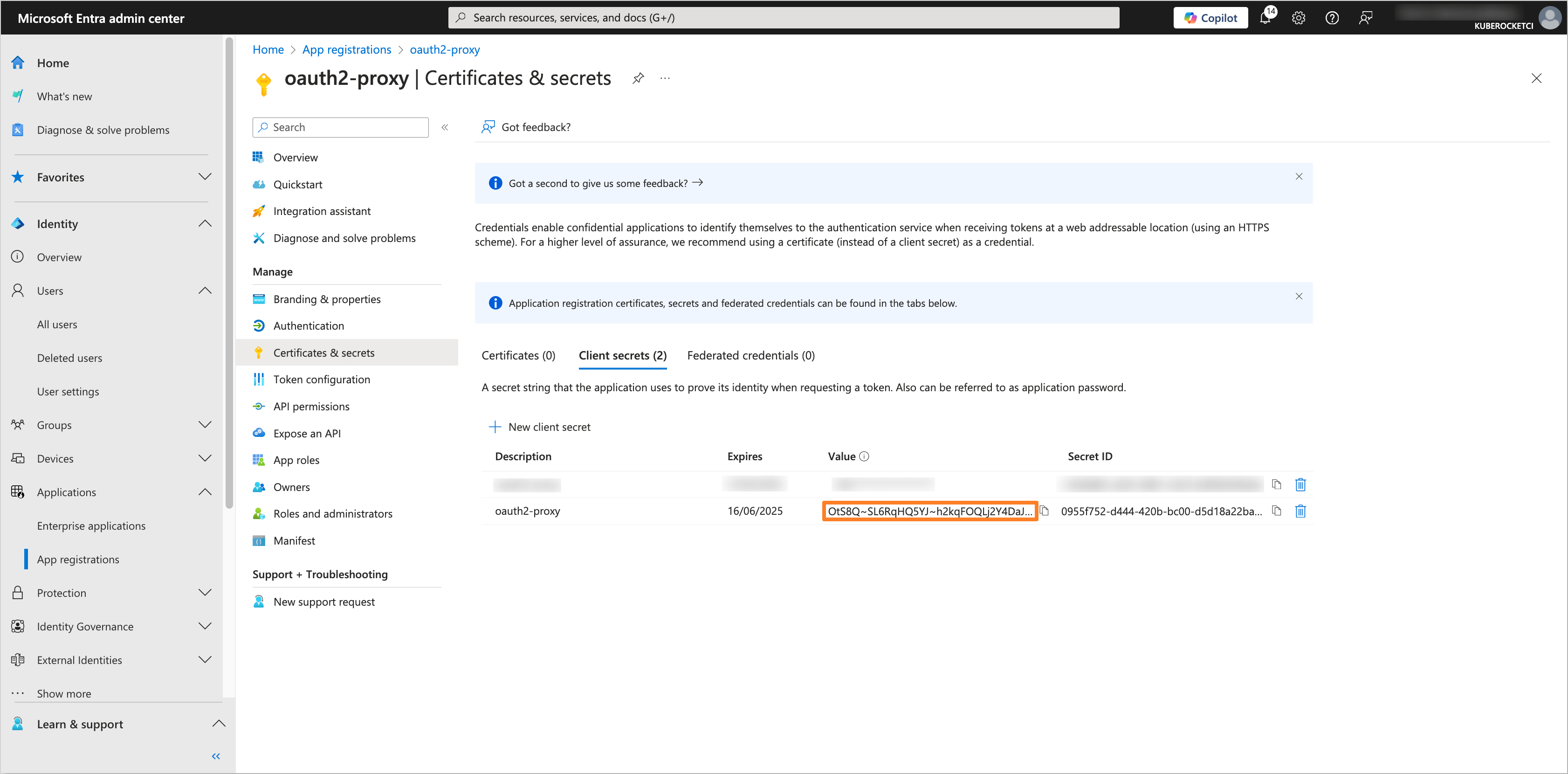
-
Navigate to the Token configuration section and click on Add groups claim button. Choose the group type as Security Groups and for the ID token type, select Group ID.
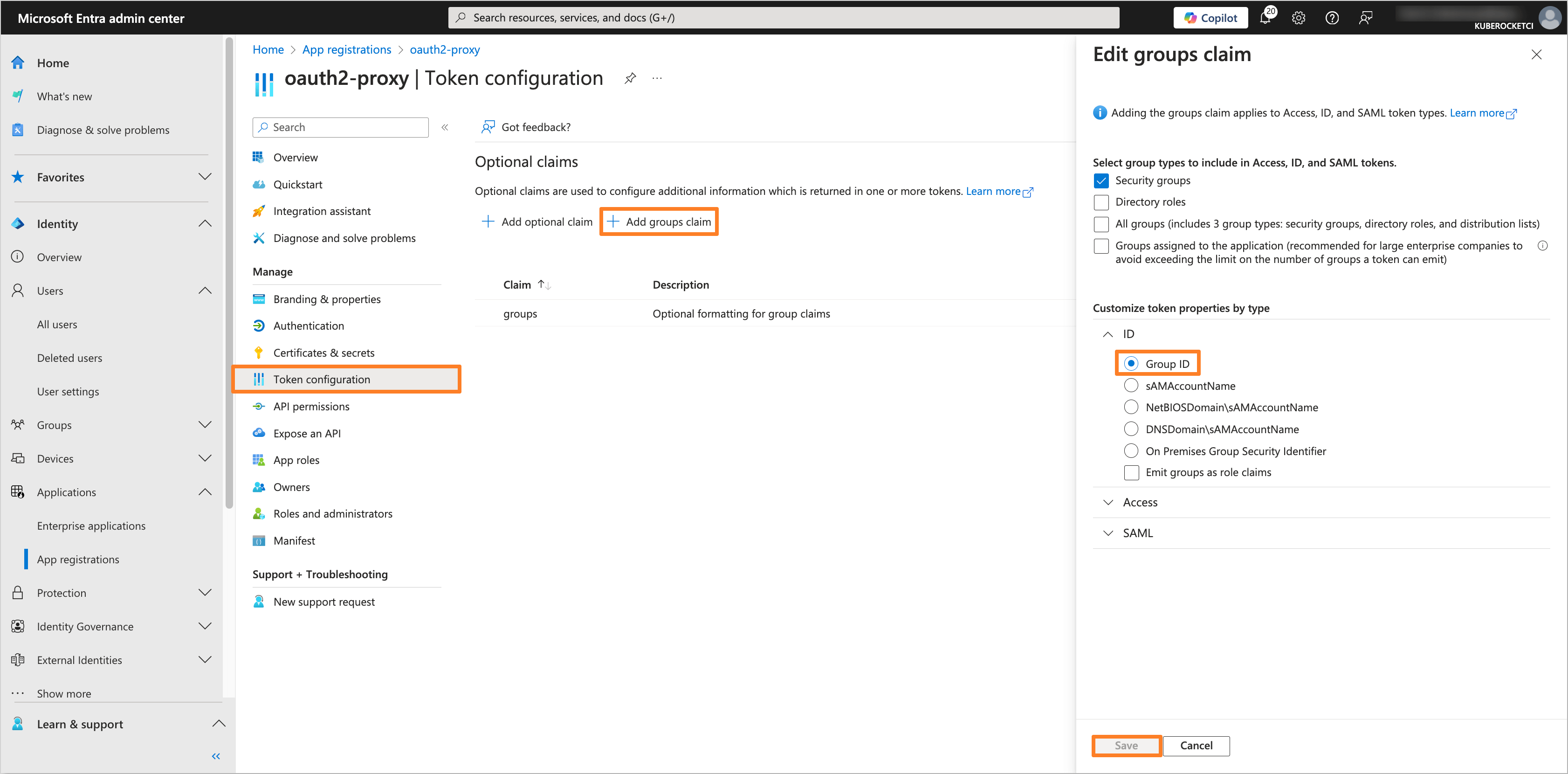
-
Navigate to the API permissions section. Click on the Add a permission button. Select Microsoft Graph and then Delegated permissions. Add the following permissions:
- openid
- profile
- User.Read
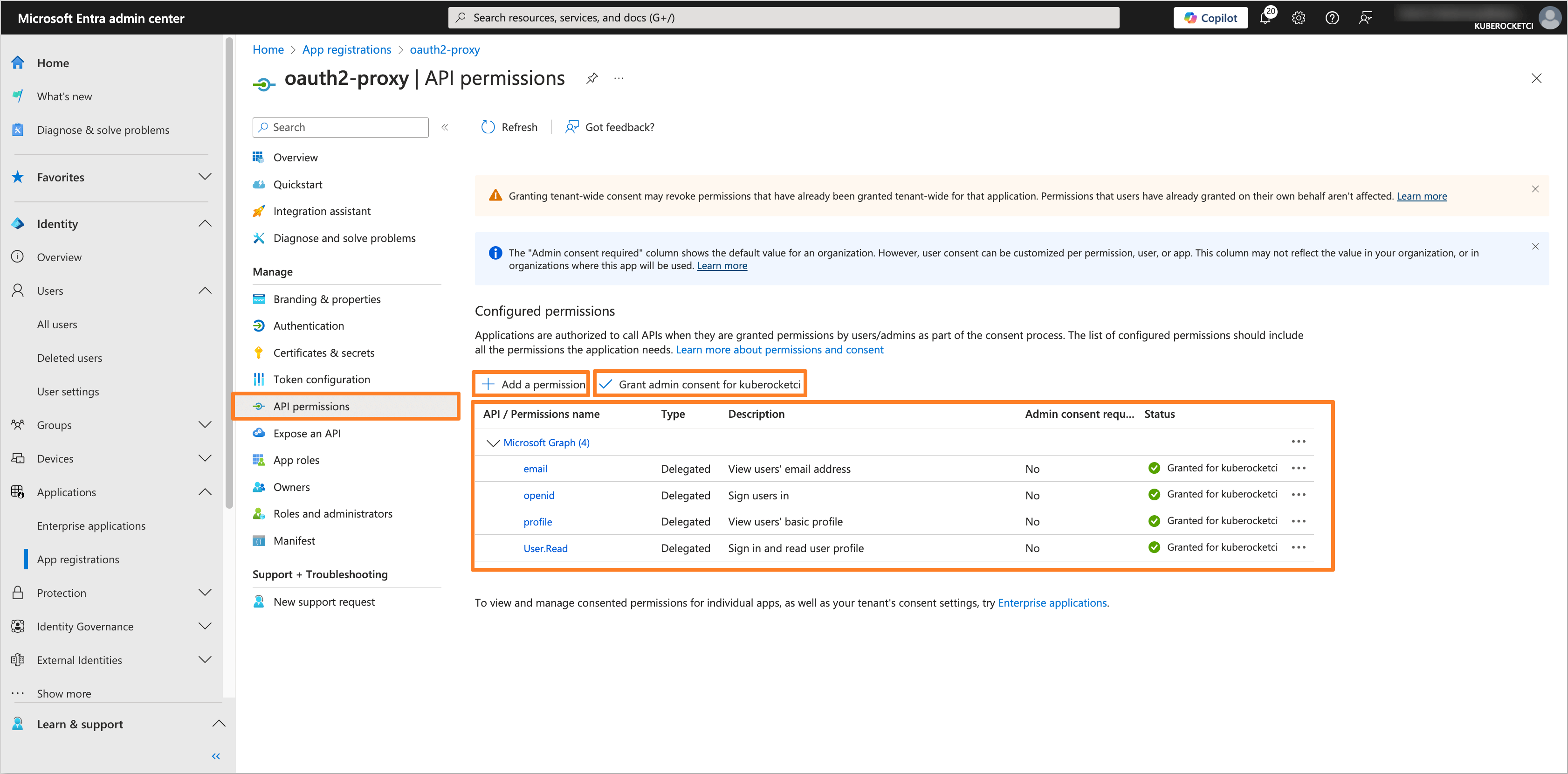
After adding the permissions, click on the Grant admin consent for 'Tenant name' button to grant the required permissions.
After the application is configured, you can proceed with the OAuth2-proxy Helm chart configuration.
Creating the Groups
To manage access to the Tekton Dashboard (or any other application with OAuth2-proxy), it is necessary to create groups in the Microsoft Entra Admin Center and assign users to it.
-
In the Microsoft Entra Admin Center, in the left sidebar menu, select Groups and then All groups. Click on New group button to create a new group(s) for users who will have access to Tekton Dashboard (e.g.,
administrator,developer).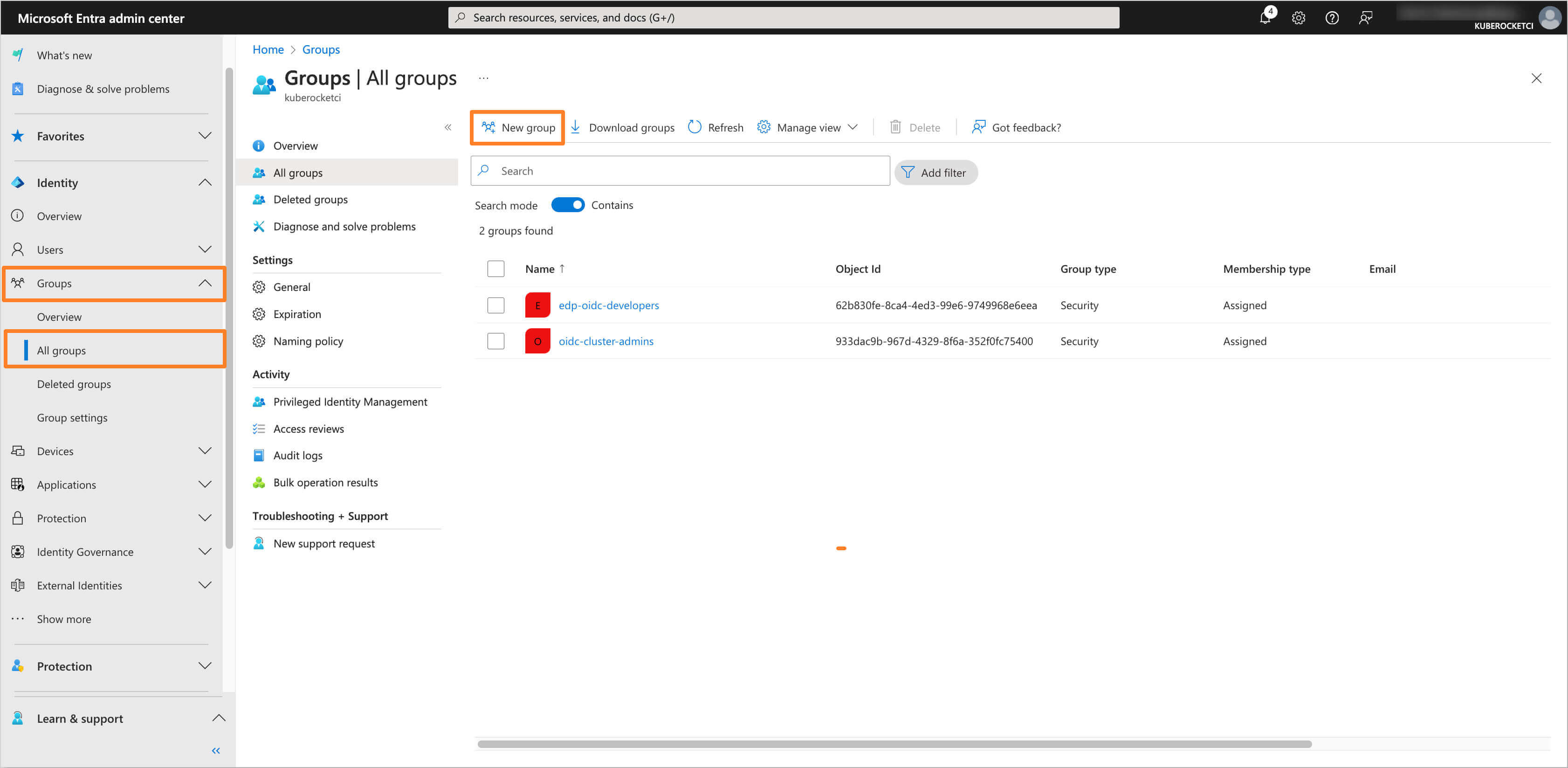
-
Fill in the required fields, such as Groups type and Group name. In the Members section, add users who will have access to SonarQube.

-
After adding the necessary members, review the group settings and click Create to save the group. Repeat this process for each required group.
Configuring OAuth2-proxy Helm chart
To integrate OAuth2-proxy with the configured Microsoft Entra Application, it is necessary to configure the OAuth2-proxy Helm chart.
The Application data, such as Application (client) ID and Directory (tenant) ID, can be found in the Overview section of the Application in the Microsoft Entra Admin Center.
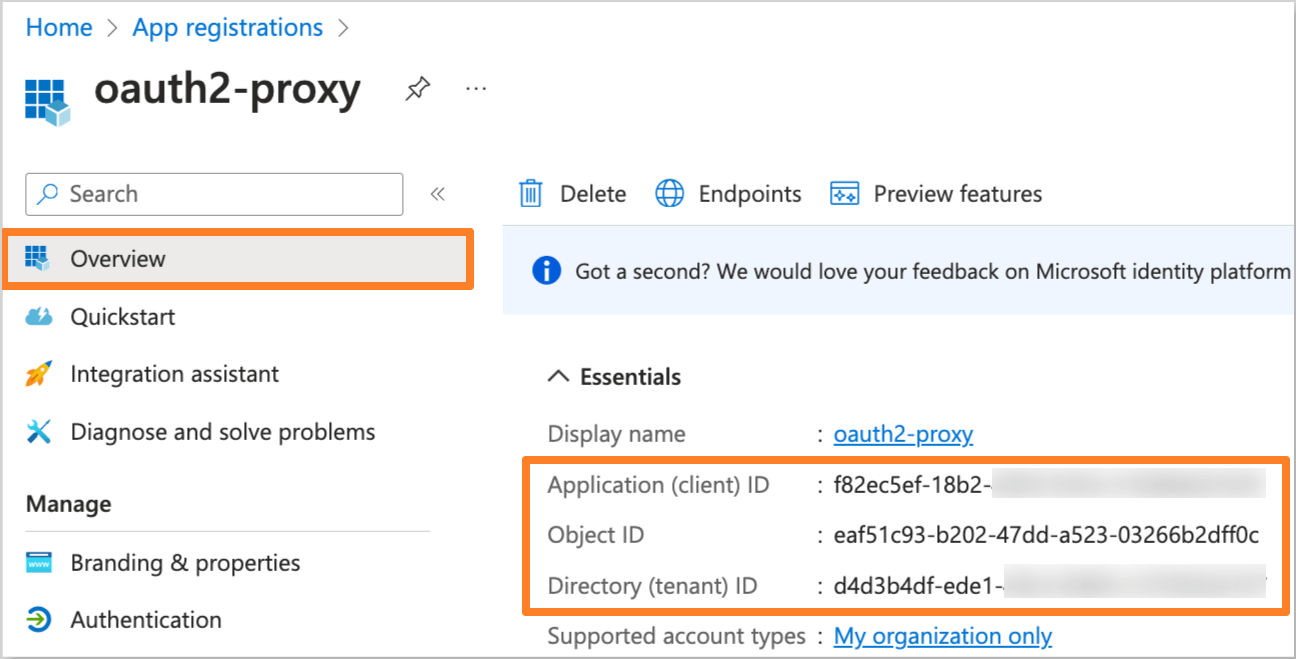
The Object ID can be found in the Overview section of the group in the Microsoft Entra Admin Center.

-
Navigate to the forked Cluster Add-Ons repository and locate the
values.yamlfile in theclusters/core/addons/oauth2-proxydirectory.Update the
values.yamlfile with the following values:clusters/core/addons/oauth2-proxy/values.yamloauth2-proxy:
config:
configFile: |-
allowed_groups = ["<Object ID of Administrator Group>", "<Object ID of Developer Group>"]
code_challenge_method="S256"
azure_tenant = "<Directory (tenant) ID>"
client_id = "<Application (client) ID>"
cookie_domains = ["example.domain.com"]
cookie_secure = "false"
email_domains = [ "*" ]
insecure_oidc_allow_unverified_email = "true"
oidc_issuer_url = "https://login.microsoftonline.com/<Directory (tenant) ID>/v2.0"
pass_authorization_header = "true"
pass_basic_auth = "false"
pass_user_headers = "true"
oidc_email_claim = "preferred_username"
provider = "oidc"
redirect_url = "https://oauth-oauth2-proxy.example.domain.com/oauth2/callback"
reverse_proxy = "true"
skip_jwt_bearer_tokens = "true"
skip_provider_button = "true"
whitelist_domains = ".example.domain.com"
scope = "openid email profile"
existingSecret: oauth2-proxy
ingress:
enabled: true
hosts:
- oauth-oauth2-proxy.example.domain.comReplace the following placeholders with the actual values:
<Object ID of Administrator Group>- Object ID of theadministratorgroup created in the Microsoft Entra Admin Center.<Object ID of Developer Group>- Object ID of thedevelopergroup created in the Microsoft Entra Admin Center.<Directory (tenant) ID>- Directory (tenant) ID of the Microsoft Entra Tenant.<Application (client) ID>- Application (client) ID of the Microsoft Entra Application created in the previous step.example.domain.com- Domain name associated with the OAuth2-proxy.
-
Update or create the
oauth2-proxysecret with the Application Client Secret value.-
Using External Secrets Operator
Be sure to update the AWS Parameter Store object path specified in the
clusters/core/addons/oauth2-proxy/values.yamlfile in theeso.secretNamefield with theclient-id,client-secretandcookie-secretvalues.noteclient-idrefers to the Application (client) ID of your Microsoft Entra Application.client-secretrefers to the Application Client Secret value of your Microsoft Entra Application.cookie-secretis a randomly generated secret value.
AWS Parameter Store object{
"oauth2-proxy": {
"client-id": "<Application (client) ID>",
"client-secret": "<Application Client Secret>",
"cookie-secret": "<Randomly generated secret>"
}
} -
Manual approach
Create the
oauth2-proxysecret manually using the following template:oauth2-proxy-secret.yamlapiVersion: v1
kind: Secret
metadata:
name: oauth2-proxy
namespace: <namespace>
type: Opaque
data:
client-id: <Application (client) ID>
client-secret: <Application Client Secret>
cookie-secret: <Randomly generated secret>Replace
<Application (client) ID>,<Application Client Secret>, and<Randomly generated secret>with the appropriate values.
-
-
After updating the
values.yamlfile and creating theoauth2-proxysecret, commit the changes to the repository and apply the changes with Helm or Argo CD.
After the OAuth2-proxy is configured, it can serve as a reverse proxy, enabling secure access to various applications by handling authentication and passing validated user identity data.
Configuring Tekton Dashboard
To configure the Tekton Dashboard to use OAuth2-proxy for OIDC authentication, it is necessary to update the Tekton Dashboard Ingress resource.
-
Log in to the Kubernetes cluster where the Tekton Dashboard is installed.
-
Edit the Ingress resource associated with the Tekton Dashboard by adding
auth-signinandauth-urlof oauth2-proxy to the annotations.kubectl annotate ingress <application-ingress-name> -n <namespace> \
nginx.ingress.kubernetes.io/auth-signin='https://<oauth-ingress-host>/oauth2/start?rd=https://$host$request_uri' \
nginx.ingress.kubernetes.io/auth-url='http://oauth2-proxy.oauth2-proxy.svc.cluster.local:80/oauth2/auth'Replace the following placeholders with the actual values.
-
Verify that the OIDC authentication is configured correctly by accessing the Tekton Dashboard URL and logging in with the Microsoft Entra credentials.
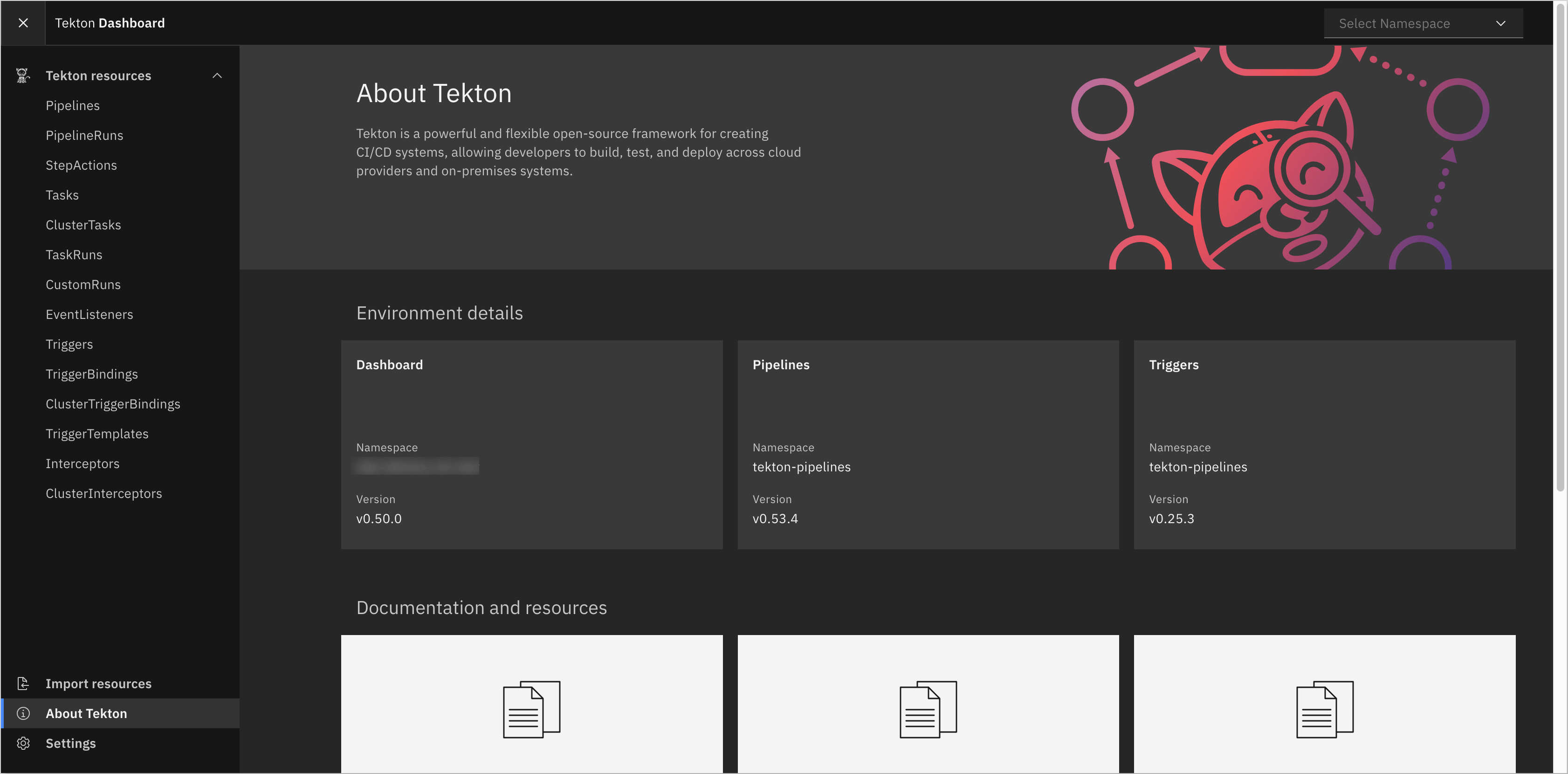
After completing these steps, the Tekton Dashboard will be configured to use OAuth2-proxy with Microsoft Entra as the Identity Provider for authentication. Users will be able to log in to the Tekton Dashboard using their Microsoft Entra credentials.